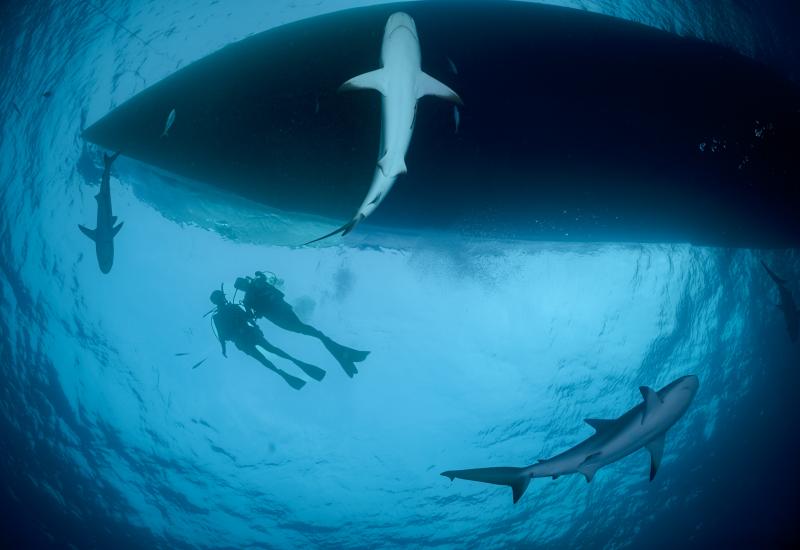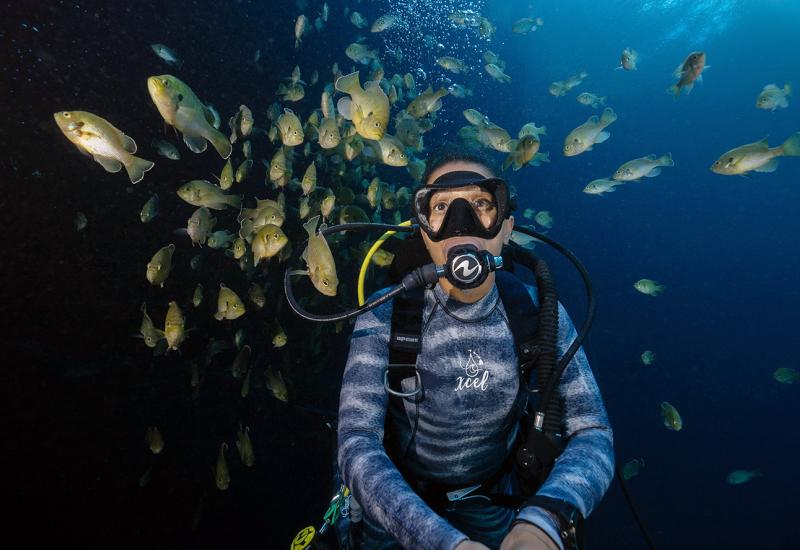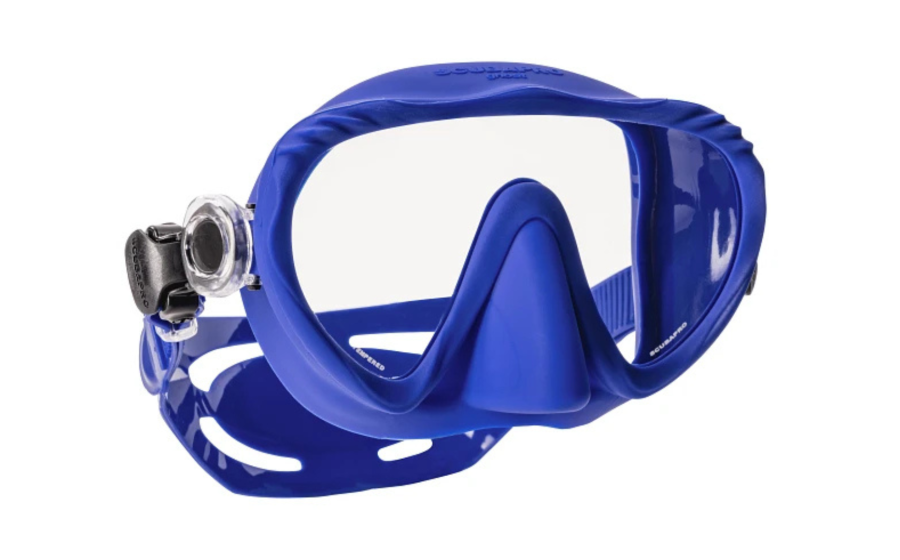ScubaLab Tests 11 Hot Dive Computers
We live in a Golden Age of dive-computer technology. Over the past two decades, these machines have evolved into powerful data centers capable of monitoring virtually all aspects of our diving. We collected 11 new and redesigned models, and tested them in our ScubaLab shop and at Blue Grotto in Williston, Florida. The results of these data-collecting exercises form the basis of the following reviews.

Katy Danca Galli
Wristwatch-style computers: for divers who want a compact, fully capable machine that can pull double duty as a stylish everyday timepiece
1. OCEANIC OCS
Performance: Housed in a lightweight composite casing reinforced with stainless steel, the OCS is loaded with all the advanced computing goodies, plus throws in Oceanic’s Dual Algorithm feature. In the water it is easy to read, the safety-stop countdown is top drawer, and the audible alarms and flashing LED warnings impressed test divers. The menu system cuts a clear path through various modes, usually without the need to reference the owner’s manual, which is the best in this category.
Liberal or Conservative: You can dive liberally or conservatively simply by picking the appropriate algorithm. In both you can further customize by using the Conservative Factor setting or adjusting the tissue loading bar-graph alarm.
Bottom Line: The OCS is a full-featured wristwatch dive computer and a solid test-diver favorite that ran a close second in rankings behind the Matrix.
SPECS: OPERATIONAL MODES- Air, Nitrox, Gauge, Free Dive | NITROX CAPABILITY- 21 percent to 100 percent | O2 GAS MIXES- 3 USER CONTROLS- 4 buttons | AIR-INTEGRATED- No | ONBOARD COMPASS- Yes | COLOR HIGHLIGHTS- No | PC KIT- Optional ($94.95) MSRP $699.95 INFO oceanicworldwide.com

Katy Danca Galli
2. SCUBAPRO MERIDIAN
Performance: The Meridian adds advanced dive computing to a classy timepiece made of marine-grade stainless steel. The display mixes digits and icons, and the four control buttons have a well-machined spring action backed by confirming beeps. In the water, there are all the data tracking features you could want. However, test divers felt this data wasn’t presented as clearly as other DCs in the category. Word prompts that alternate between uppercase and lowercase can be a little hard to read until you get used to it. One admired capability of the meridian is the optional heart-rate monitor that adapts the decompression algorithm.
Liberal or Conservative: The Meridian’s algorithm runs middle of the road. It offers five additional settings for increasing conservatism.
Bottom Line: The Meridian is an attractive, muscular data cruncher that does it all, just not as easily as others in this category.
SPECS:
OPERATIONAL MODES- Air, Nitrox, Gauge, Apnea | NITROX CAPABILITY- 21 percent to 100 percent | O2 GAS MIXES- 2 USER CONTROLS- 4 buttons AIR-INTEGRATED- No ONBOARD COMPASS- No COLOR HIGHLIGHTS- No PC KIT- Optional ($130) MSRP $649 INFO scubapro.com

Carrie Garcia
3. MARES Matrix
Performance: With so many features packed into such a compact unit, the matrix is a wonder. Offering well-marked buttons and an intuitive menu, it ranked the easiest DC to program in this category. The model provides excellent screen readability with its reverse color band highlighting no deco data, and it has a very usable tissue loading bar graph and a cool graphic dive-profile alternate screen. It also comes with the bar-none best compass in its category. Another unique feature is the Ice (in case of emergency) function, which shows personal info — from contact numbers to insurance policies to allergies. The Matrix is powered by a rechargeable lithium battery, so you have to remember to plug it in once in a while. However, it does offer an “Off” mode to conserve battery power.
Liberal or Conservative: The Matrix leans conservative, plus provides three altitude settings and two additional safety levels to increase your cushion.
Bottom Line: The Matrix is a wristwatch dive computer on steroids. It’s easy to read and program, and full of advanced features. Test divers unanimously picked it as Testers’ Choice in this category.
SPECS: OPERATIONAL MODES Air, Nitrox, Gauge | NITROX CAPABILITY 21 percent to 99 percent O2 GAS MIXES 3 | USER CONTROLS 4 buttons | AIR-INTEGRATED No | ONBOARD COMPASS Yes | COLOR HIGHLIGHTS Yes | PC KIT Included MSRP $700 | INFO mares.com

Katy Danca Galli
4. SUUNTO D6I
Performance: The big news with the D6i is a new option to add hoseless air integration. Also new is a sapphire-glass display, which Suunto says is more scratch resistant than the previous mineral-glass display. plus a slick-looking new color — all white. Otherwise, the D6i continues to offer an easy-reading display with big bold digits and color-coded bar graphs. Test divers liked the tissue loading bar graphs and especially the ascent bar graph. The full-tilt 3-D compass is one of the best designs in this category. However, the safety-stop countdown doesn’t use seconds, which test divers found wanting when compared with other models. programmingwise, the D6i is a quick study, enabling testers to navigate with success once they got used to the button functions.
Liberal or Conservative: The D6i’s algorithm runs conservative, and three personal adjustment settings and three altitude settings can make it even more so.
Bottom Line: The updated D6i is an attractive DC that packs a lot of computing punch and delivers it with a user-friendly interface.
SPECS: OPERATIONAL MODES- Air, Nitrox, Gauge, Free Dive | NITROX CAPABILITY- 21 percent to 100 percent | O2 GAS MIXES- 2 | USER CONTROLS- 4 buttons AIR INTEGRATED- Optional | ONBOARD COMPASS- Yes | COLOR HIGHLIGHTS- Yes | PC KIT- Included MSRP $1,100 ($1,595 with transmitter) INFO aqualung.com

Katy Danca Galli
Wrist-mount computers: for data-hungry divers who require instant information with the most convenient package possible
1. AERIS A100
Performance: The A100 is the bare-bones entry in this year’s test group. It uses only a single button for navigation and offers air or nitrox mixes to 50 percent. There are no audible alarms, no backlight and no ability to download data. The A100 does, however, come with Aeris’ Dual Algorithms feature, which is a big plus. Like the A300, it uses easy-to-read green/yellow/red bar graphs to monitor nitrogen loading and ascent rate. Its safety-stop countdown system is also quite good. In spite of its single button, navigating through the A100 system is surprisingly simple. Getting the hang of the sequencing took testers no time at all, with only minimal reference made to the A100’s well-laid-out manual.
Liberal or Conservative: With its Dual Algorithms feature, you can choose your computing model based on current dive conditions, or to match your buddy’s dive computer.
Bottom Line: A simple, inexpensive model that’s relatively easy to use, the A100 offers most DC functions plus throws in dual algorithms. And it’s also available in a console.
SPECS: OPERATIONAL MODES- Air, Nitrox | NITROX CAPABILITY- 21 percent to 50 percent | O2 GAS MIXES- 1 | USER CONTROLS- 1 button AIR INTEGRATED- No | ONBOARD COMPASS- No | COLOR HIGHLIGHTS- Yes | PC KIT- No MSRP $309.95 INFO diveaeris.com

Carrie Garcia
2. Aeris A300
Performance: While it might look old school, this DC is packed with modern computing features like three-gas capability to 100 percent O2 and Aeris’ Dual Algorithms. The primary screen offers current depth and no-deco time, with the rest of the data relegated to alternate screens. Some test divers considered this a clean presentation. Others wanted to see more data on the primary screen. Either way, you can’t mistake the big, bold data digits. The A300 provides a very good safety-stop countdown, plus it uses three-color bar graphs with extended pixel loading that makes tracking tissue loading and ascent rate extremely easy. The A300’s button system is intuitive, and its owner’s manual is one of the best.
Liberal or Conservative: Dual algorithms enable you to dive liberally or conservatively. A Conservative Factor setting increases the safety level.
Bottom Line: With Dual Algorithms and a display screen that makes excellent use of colored bar graphs, plus a very reasonable price, the A300 is a Best Buy.
SPECS: OPERATIONAL MODES Air, Tech, Gauge, Free Dive | NITROX CAPABILITY 21 percent to 100 percent O2 | GAS MIXES 2 USER CONTROLS 3 buttons | AIR INTEGRATED No | ONBOARD COMPASS No COLOR HIGHLIGHTS Yes | PC KIT Optional ($94.95) MSRP $409.95 INFO diveaeris.com

Carrie Garcia
3. MARES Icon HD/AI
Performance: In a class all its own, this impressive data cruncher hit the scene a couple of years ago, bowling everybody over with its big, bright, full-color LCD and smartphone-style menu. Improvements to this latest model include an upgraded system that adds options to dive modes and expanding functions to its already excellent compass. But the big news is the addition of hoseless air integration. The color coding for bar-graphing tissue loading, deco time and ascent rate is unmatched. And the blinking red banner for too-fast ascents really gets your attention. Of course, all of this vibrant color requires lots of power. Thankfully the lithium-ion battery is rechargeable. Programmingwise, this DC is so intuitive that you can set all parameters simply by following the screen prompts.
Liberal or conservative: The Icon HD leans conservative. You can also program four altitude and three personal-safety levels.
Bottom Line: The Icon HD/AI, now with hoseless air integration, was the unanimous favorite wrist-mount DC with test divers, who didn’t hesitate a moment before picking it as the Testers’ Choice.
SPECS: OPERATIONAL MODES Air, Nitrox, Gauge | NITROX CAPABILITY 21 percent to 99 percent O2 GAS MIXES 3 | USER CONTROLS 4 buttons AIR INTEGRATED Yes | ONBOARD COMPASS Yes | COLOR HIGHLIGHTS Yes | PC KIT Included MSRP $1,800 INFO mares.com

Katy Danca Galli
4. TUSA IQ-750 ELEMENT II
Performance: The Element II is similar in appearance to the A300 but functions quite differently. The button sequencing and navigation is not as intuitive. Testers found it’s not a system you can master just by experimenting with pushing buttons; you’ll definitely need to read the manual. Luckily, the owner’s manual for the Element II is a very good one, offering logical page/function progressions and clear instructions supported by helpful illustrations. In the water, a workable primary dive screen offers basic data, plus an easily accessible alternate screen. The N2, O2 and ascent bar graphs are better than average, as is the safety-stop function.
Liberal or Conservative: The Element II is middle of the road. It provides a Conservative Factor setting to increase safety.
Bottom Line: The Element II, also available in a console version with an analog SpG, is a decent dive computer with lots of features and functions. However, it requires a bit more study and patience to set it up and navigate through the system. Otherwise, you have a solid data cruncher at a good price.
SPECS: OPERATIONAL MODES- Air, Nitrox, Gauge, Free Dive | NITROX CAPABILITY 21 percent to 100 percent | O2 GAS MIXES- 2 USER CONTROLS- 3 buttons | AIR INTEGRATED- No | ONBOARD COMPASS- No | COLOR HIGHLIGHTS- Yes | PC KIT- Optional ($99) MSRP $430 INFO tusa.com

Katy Danca Galli
Console-style computers: for divers who desire a large interface with air integration for the most economical investment
1. SUBGEAR XP-H
Performance: Divers who like to streamline their profile with the most compact gear possible will appreciate this full-featured air-integrated DC that measures just over two inches in diameter and weighs only 5 ounces. Our test divers found the data screen to be less intuitive than others. Data digits are all the same size, and their labels are tiny, so it can be a bit hard to decipher. There is a three-color bar graph for tracking tissue loading, but it’s very narrow and can be difficult to see at depth. The dual control buttons are not marked, and require a series of short and long pushes to navigate through the system. Testers rated it the most frustrating computer to program in this year’s go-round, but they loved the tiny size and minimalist design.
Liberal or Conservative: The XP-H’s algorithm runs middle of the road. It offers five additional settings for increasing conservatism.
Bottom Line: The XP-H provides all the info you want, it’s just difficult to see it, to find it and to program it. However, once dialed in, this DC offers a lot of computing power plus air integration in an ultracompact package — and at a reasonable price.
SPECS: OPERATIONAL MODES- Air, Nitrox, Gauge | NITROX CAPABILITY- 21 percent to 100 percent | O2 GAS MIXES- 1 | USER CONTROLS- 2 buttons AIR INTEGRATED- Yes | ONBOARD COMPASS- No | COLOR HIGHLIGHTS- Yes | PC KIT- Optional (from $65) MSRP $475 INFO subgear.com

Carrie Garcia
2. Aeris A300AI
Performance: Offering one of the most intuitive menu systems in the test group, the A300AI is not only a do-it-all data cruncher, it’s also falling-down simple to use. All computer and dive parameters can be easily set without ever cracking the manual. Featurewise, the A300AI is fully loaded with Aeris’ Dual Algorithms and the option of four gas mixes. Test divers liked the sleek console and the presentation of all data on one customizable primary screen. The red LED flashing alarm was also a plus, although feelings were mixed about the audible alarms as well as the compass, which, in contrast to the rest of the unit, was not so intuitive.
Liberal or Conservative: Dual Algorithms let you have it your way, plus a personal Conservative Factor lets you match your algorithm to the conditions.
Bottom Line: With the exception of an unimpressive compass, the A300AI offers virtually everything you’d ever need in a dive computer, presented simply and intuitively. For that, test divers named it this year’s Testers’ Choice in the console category.
SPECS: OPERATIONAL MODES Air, Nitrox, Gauge | NITROX CAPABILITY 21 percent to 100 percent O2 | GAS MIXES 4 | USER CONTROLS 3 buttons AIR INTEGRATED Yes | ONBOARD COMPASS Yes | COLOR HIGHLIGHTS Yes | PC KIT Included MSRP $949.94 to $1,049.95 INFO diveaeris.com

Katy Danca Galli
3. SHERWOOD WISDOM 3
Performance: The third version of this popular console comes with expanded memory, full-time access to No Deco Limits regardless of the Air Time Remaining, a new approach to Dive Time Remaining, and an eye-pleasing new white casing. The Wisdom 3 has a huge, easy-to-read display that presents data on four levels. Each section is labeled, and at the top of each screen is a prompt alerting to the mode, so it’s virtually impossible to get lost. The two-button navigation system is intuitive, and test divers were impressed by the expansive screen with big data digits. Another plus, standout bar graphs track N2 and O2 tissue loading as well as ascent rate. Testers felt the optional quick-disconnect that separates DC from regulator was a must-have item.
Liberal or Conservative: The Wisdom 3 is the most liberal dive computer in this test group. Although there is no way to program in a conservative setting, a safety cushion can be factored in by simply backing off on pixels on the NDL loading bar.
Bottom Line: The Wisdom continues to be a major player in the traditional big-screen console category. Test divers found it holds its own quite handily against most late-model DCs on the market today.
SPECS: OPERATIONAL MODES- Air, Nitrox, Gauge | NITROX CAPABILITY- 21 percent to 50 percent | O2 GAS MIXES- 1 | USER CONTROLS- 2 buttons AIR INTEGRATED- Yes | ONBOARD COMPASS- No (Analog) | COLOR HIGHLIGHTS- Yes | PC KIT- Optional ($105) MSRP $911 to 940 INFO sherwoodscuba.com
We live in a Golden Age of dive-computer technology. Over the past two decades, these machines have evolved into powerful data centers capable of monitoring virtually all aspects of our diving. We collected 11 new and redesigned models, and tested them in our ScubaLab shop and at Blue Grotto in Williston, Florida. The results of these data-collecting exercises form the basis of the following reviews.










